The History of Human Brain Surgery in Brain Research
Early Brain Surgery History
The thought of brain surgery and the correction of mental illness began around 1890, when Friederich Golz, a German researcher removed temporal lobes of his own dogs and found them to be less aggressive.
Around that same time, Gottieb Burkhard, the head doctor of a Swiss mental institution, did six similar surgeries on schizophrenic patients. Out of the six, two of the patients died , but the other four became calmer.
In 1935 a Yale doctor, Carlyle Jacobsen, performed lobotomies on chimps and found them to be calmer (Noble Lectures, 1964).
Antonio Egaz Moniz of the University of Lisbon Medical School was a medical researcher. He did contribute significant contributions to the brain x-ray techniques. He also contributed to the push towards lobotomies.
Moniz discovered that in cutting the nerves of the frontal cortex in psychotic patients, he could “short-circuit” part of the problem. This procedure consisted of drilling holes in the sides of the forehead of patients, then inserting a knife, then severing the prefrontal cortex from the rest of the brain (Sabbatini, 1997).
Most patients did not become calmer after this procedure. To his credit, Moniz did advise that the lobotomy should only be used in extreme cases when all other interventions had failed. He received the Noble Prize in 1949 for his work on the lobotomy, but he became paralyzed when one of his “lobotomy” patients shot him in the back (Boeree, 2001).
An American physician, Walter Freeman, was
the person most responsible for bringing the lobotomy to America in
1936. He performed thousands of lobotomies and began a propaganda campaign to
promote the surgery.
Freeman invented the “ice pick lobotomy”. He found that when he used an ice pick and inserted it above each eye of the patient with only a local anesthetic (sometimes only shock therapy) and then “drove it thought the thin bone by tapping the pick with a mallet, swish it back and forth like a windshield wiper, pull the pick out, and the patient’s lobotomy was completed” (El-Hai, 2005).
Freeman claimed that the lobotomy could cure everything from psychosis, neurosis, depression, criminality, headaches, menstrual cramping, to “difficult children”. He developed an “assembly line type lobotomy”. He gave lectures to promote the lobotomy.
Dr. Freeman tried to see if he could break his own lobotomy speed records. During his career he performed an estimated 3,500 lobotomies. It is important to note that the lobotomy was thought of as a miracle cure for mental illness at this time (El-Hai, 2005).
Human Brain Research History of Ancient Rome, Asia, & Middle Ages
Back to Page 1 of Human Brain Research History
Disclaimer: This website and its content is intended for trained licensed mental health professionals and school certified mental health professionals to use for their clients / students at their own discretion.
*If you ignore the disclaimer above are using these techniques on yourself and you feel any discomfort or upset it is highly suggested that you seek out a licensed mental health professional immediately.
"Beyond Art Therapy" is the concept from Dr. Stangline that combines all creative fields in therapy. It is not the traditional "art therapy" but goes beyond to include sand tray therapy, play therapy, mindfulness, meditation, color therapy, cognitive behavioral therapy, and a vast majority of other therapies.
For any other type of mental health emergency call your local 911 / Police Number immediately.
Dr. Stangline does not offer advice / suggestions to anyone who is not a professional mental health provider, or a student who is studying this field and has questions about mental health programs of study.
See our Exciting Selection of eBooks:
Award Winning:
Creative Counseling 101 eBook
Our Best Seller!
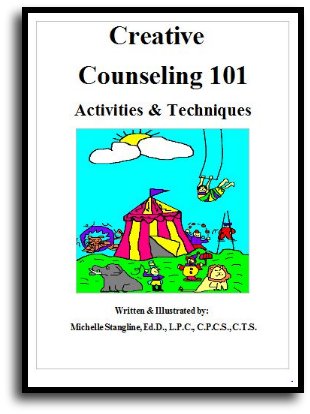
Step By Step Therapy:
Learn how to be a more Creative Therapist with the Book that started it all!
- Graduate School Counseling book used by hundreds of graduate counseling students!
- Includes full color reproducible worksheets with most activities.
- Winner of the Counselor Writer of the Year Award, 2011, Georgia Regional Award
Download Your Copy Today Only $39.95:
See Creative Counseling 101 eBook Information Here:
Get the Set
of all four
eBooks for only $98.95:
An incredible collection of how to do therapy eBooks!
A $159.80 Value,
You Save Over $60!
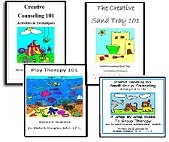
Get your complete set of the Creative Counseling 101.com eBooks by Dr. Michelle Stangline for only $98.95, that's less than $25.00 per eBook (Regular Price is $39.95 for each eBook.).
Your complete set includes:
- Creative Counseling 101
- Creative Group Counseling 101
- Creative Play Therapy 101
- Creative Sand Tray 101
For more information click the link below:
See Complete Set of eBooks For Sale Here:
New!!! "Beyond Art Therapy" 101 eBook
Over 300 pages of Beyond Art Therapy activities and techniques. Learn what I teach graduate counseling students!
See the link below for more information.
Only $39.95
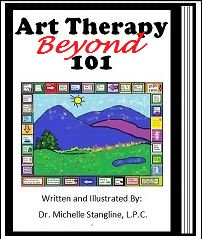
See More Invividual eBooks For Sale:
Sand Tray Therapy 101 eBook:
Learn how to do Sand Tray Therapy or enhance your skills.
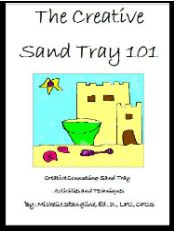
Play Therapy 101 eBook
Learn how to do play therapy or enhance your skills.
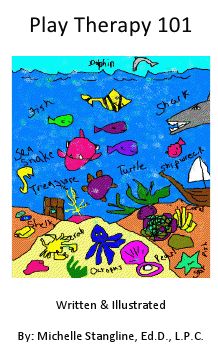
Small Group Counseling eBook For Sale:
Learn how to do creative group therapy and enhance your skills.
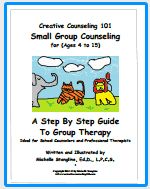
School Counselor Guidance Lesson & Social Stories eBook for sale:
Get a year's worth of school counselor guidance lessons with "Creative Warm & Fuzzy Classroom Guidance Lessons eBook". Introduce your students to the "Warm & Fuzzy Way". Click the link below for more information:
Warm & Fuzzy School Counselor Guidance Lessons eBook
